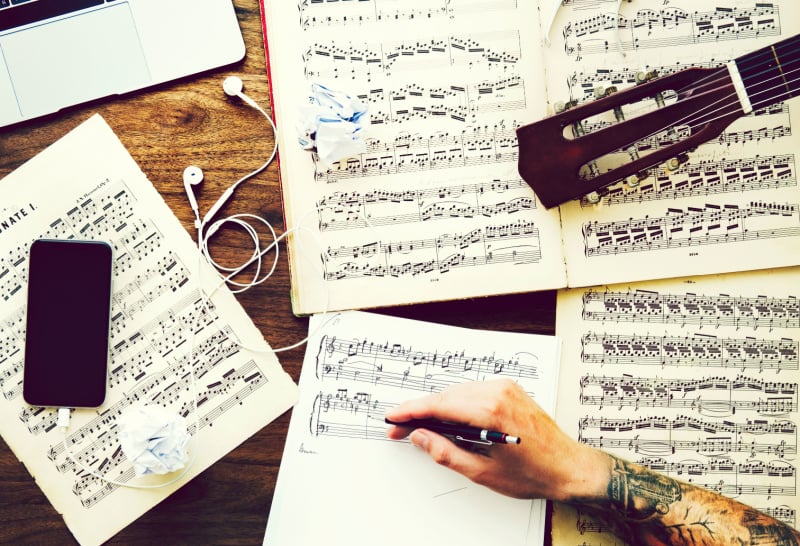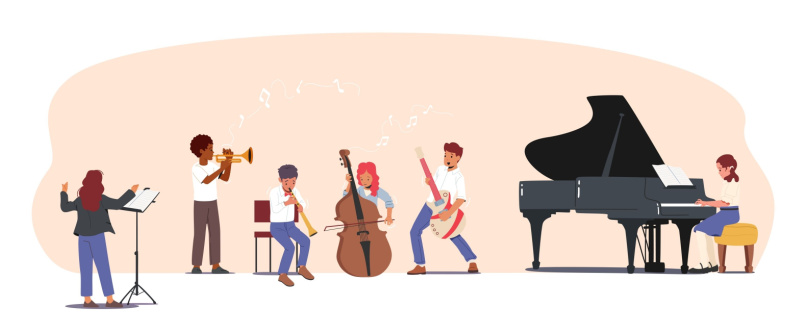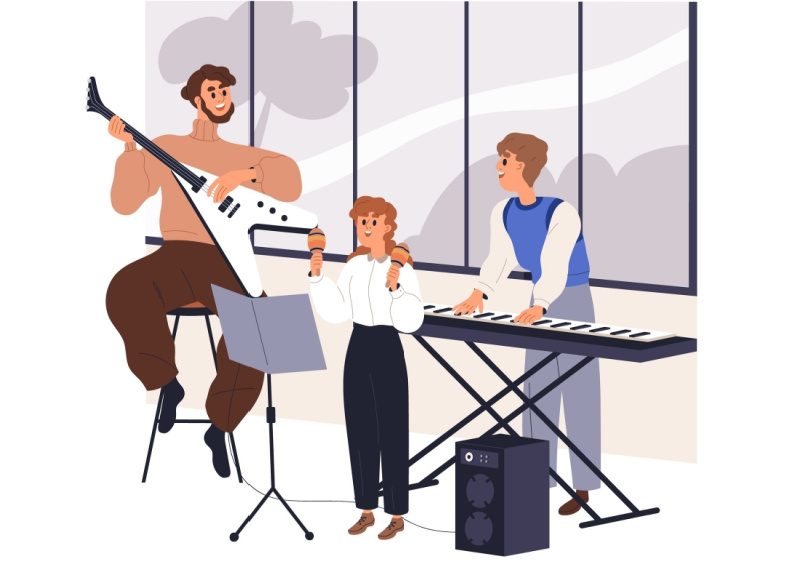Music theory is the group of terms and symbols that musicians use to communicate about how music is made and the different elements of a musical composition. Understanding music theory can help beginners to get started making music and more advanced musicians to learn and create new compositions.

The Elements of Music
There are eight different elements of music that work together to contribute to a single musical composition: dynamics, form, harmony, melody, rhythm, texture, timbre, and tonality. By changing one or more of these elements, a composer or musician can change the final piece produced and its effect on the listener.
Dynamics are indications of how loudly or softly you should play or sing. The two main dynamics are piano, meaning quiet, and forte, meaning loud. Modifiers are added to these terms to represent the full dynamic range, such as “mezzo-,” meaning “moderately.” From quietest to loudest, dynamics are pianississimo (very, very quiet), pianissimo (very quiet), piano (quiet), mezzo-piano (moderately quiet), mezzo-forte (moderately loud), forte (loud), fortissimo (very loud), and fortississimo (very, very loud).
Form, also sometimes referred to as the structure of a musical composition, is the order in which the different sections of a piece are arranged. In pop music, for example, a composition might feature an introduction, verse, chorus, verse, chorus, bridge, chorus, and outro. Classical music may have a more complex form.
Harmony, at its simplest, is the sound that is created when notes in two or more pitches are being played at the same time. This forms a chord. The harmony provides the support needed for the melody.
Melody is the main tune in a musical piece. It is made up of a series of pitches and is typically carried by the soprano section.
Rhythm is the timing of music and how the harmony and melody progress in a piece of music. It dictates how long or short each individual note is. There are several different types of rhythm that could be employed. For example, polyrhythm is when two types of rhythms are being played simultaneously. Syncopation is another type of rhythm, characterized by the emphasis not being placed on the expected beat.
Texture is a way of describing how the different parts of a musical composition come together and how many different instruments and rhythms are played at once. A piece that includes only a single melody is characterized as thin-textured or monophonic. Music with a melody and supporting chords is said to be homophonic. A polyphonic composition has a thick texture, including multiple overlapping melodies and background parts.
Timbre in music theory is the unique sound quality of an instrument or voice. The timbre of every instrument is different and may change depending on how that instrument is played.
Tonality is the overall sound of a musical composition. It could be characterized as a consonant, pleasant sound or a dissonant, unpleasant sound. The music being in a major or minor key contributes to its tonality.

Music Theory Fundamentals
Learning how music is constructed is key to appreciating the nuances of any piece and gaining a fuller understanding of what it means to create and discuss music as an art form. Through understanding the different elements of music and how they work together to balance a composition, musicians can also gain the knowledge they need to create their own compositions. Everyone employs the same principles of music theory in different ways to express their unique style or the style of a specific culture.

Music Theory Terminology Glossary
A Cappella: Singing without any accompanying instruments
Accelerando: Gradually increase the tempo
Adagio: Play slowly
Allargando: Gradually play more slowly
Allegro: Play quickly
Alto: Second in a four-part choir, this part is usually sung by women. It is in between a soprano and a tenor.
Arpeggio: Notes of a cord played in order, either ascending or descending
Baritone: The second-highest male vocal part, between a bass and a tenor
Bass: The lowest vocal part of a four-part choir
Beat: The pulse of a piece of music
Breath Mark: Formatted in vocal music with a comma-like symbol placed above the staff, this mark indicates where a singer should take a breath.
Bridge: A transition between two sections of a song, it is most often placed between a verse and a chorus.
Cadence: This is a chord progression that happens at the end of a phrase.
Chord: At least three notes played simultaneously
Chromatic Scale: This scale is made up of a dozen half-steps, including every note within an octave.
Flat: A flat is a note that is lowered on the scale by a half-step.
Half-Step: The smallest distance between two notes
Interval: The difference in pitch between two notes
Key: The group of notes used in a musical piece

Major Scale: This is the scale that major keys are based on. It uses this step pattern, in ascending order: whole, whole, half, whole, whole, whole, half.
Meter: The pattern of beats in a piece of music
Mezzo-Soprano: This is a female vocal part that is higher than an alto and lower than a soprano. It is sometimes called second soprano.
Moderato: Play at a moderate tempo
Modulation: This is the process of moving from one key to another key.
Phrase: A line of music that’s typically four measures in length and concluded with a cadence.
Pitch: The sound of a note
Sequence: This is a series of repeated notes and chords.
Soprano: The highest female vocal part, sopranos usually carry the melody of a choir. Preadolescent boys may also sing soprano parts.
Staff: A layout of four spaces and five lines that musical notes are placed on.
Tempo: The speed of a musical piece
Tenor: The highest male vocal part
Theme: A combination of rhythmic, harmonic, and melodic elements on which the musical composition is based
Time Signature: Displayed as a fraction at the beginning of a musical piece, the time signature indicates the number of beats per measure (the top number) and which note will equal one beat (the bottom number. For example, in a piece written in 4/4 time, each measure will have four beats, and a quarter note will equal one beat.
Triad: A three-note chord made up of a root, a third, and a fifth
Unison: When two different parts share the same note

Music Theory Resources
- Why Does Music Theory Matter?
- Basic Music Theory
- Worksheets on Music Theory
- Music Theory Concepts
- Basics of Rhythm
- Four-Part Writing Rules
- The Elements of Music
- Teaching the Basic Elements of Music
- Introduction to Music Theory and Composition
- The Staff, Clefs, and Ledger Lines
- Understanding the Music Alphabet
- Exploring Pitch
- Theater Seats
- The Definitive Guide to Learning Music Theory
- Fundamentals of Music Theory

